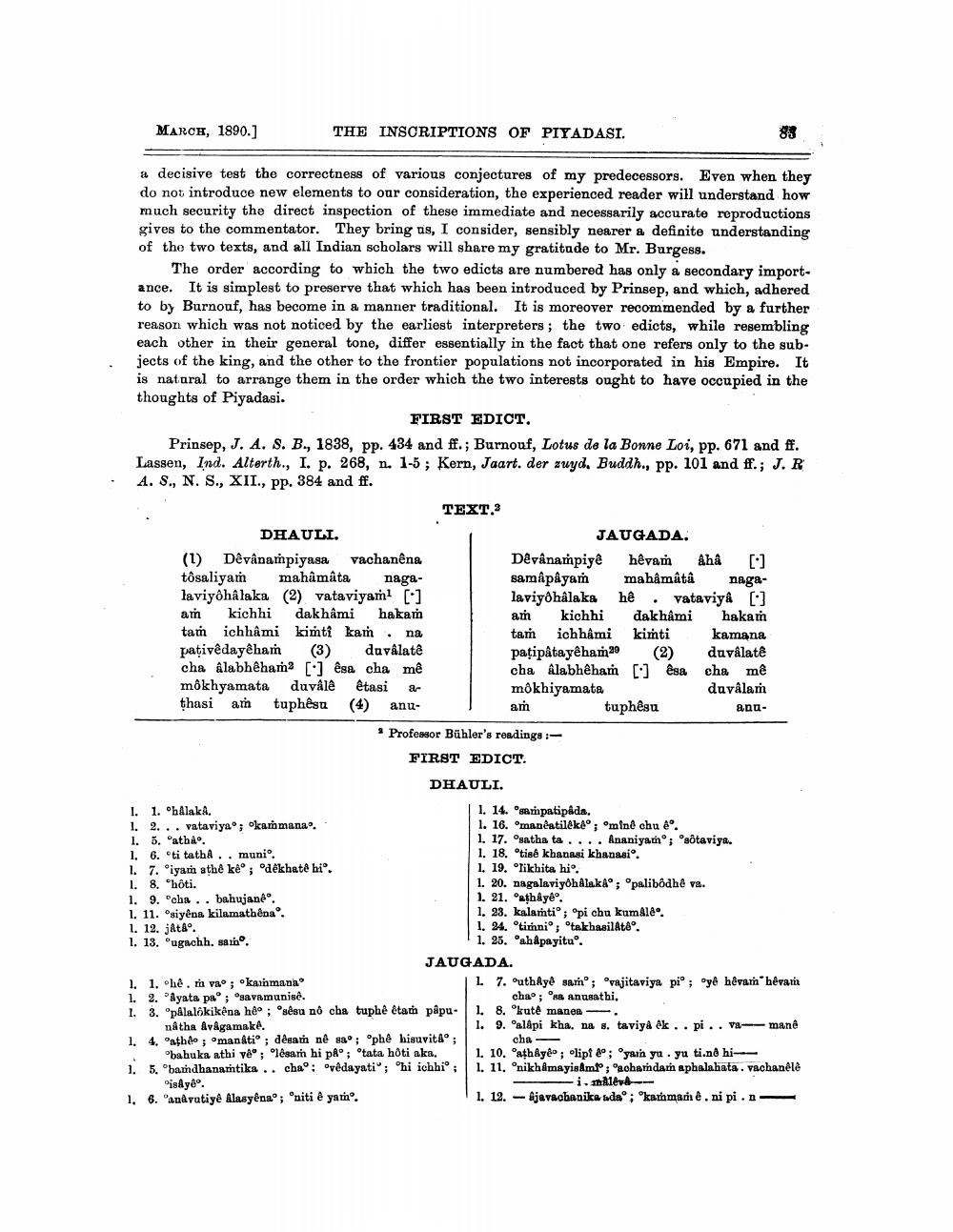________________
MARCH, 1890.)
THE INSCRIPTIONS OF PIYADASI.
83
a decisive test the correctness of various conjectures of my predecessors. Even when they do not introduce new elements to our consideration, the experienced reader will understand how much security the direct inspection of these immediate and necessarily accurate reproductions gives to the commentator. They bring us, I consider, sensibly nearer a definite understanding of the two texts, and all Indian scholars will share my gratitude to Mr. Burgess.
The order according to which the two edicts are numbered has only a secondary importance. It is simplest to preserve that which has been introduced by Prinsep, and which, adhered to by Burnouf, has become in a manner traditional. It is moreover recommended by a further reason which was not noticed by the earliest interpreters; the two edicts, while resembling each other in their general tone, differ essentially in the fact that one refers only to the subjects of the king, and the other to the frontier populations not incorporated in his Empire. It is natural to arrange them in the order which the two interests ought to have occupied in the thoughts of Piyadasi.
FIRST EDICT. Prinsep, J. A. S. B., 1838, pp. 434 and ff.; Burnouf, Lotus de la Bonne Loi, pp. 671 and ff. Lassen, Ind. Alterth., I. p. 268, n. 1-5; Kern, Jaart. der zuyd. Buddh., pp. 101 and ff.; J.R A. S., N. S., XII., pp. 384 and ff.
TEXT.2 DHAULI.
JAUGADA. (1) Dêvânampiyasa vachanêna
Dévânampiyê hêvam Aha [:] tôsaliyam mahâmâta naga
samåpåyam mahâmâtî nagalaviy halaka (2) vataviyam [-]
laviyðhâlaka hê . vataviy [:] a kichhi dakhâmi hakam
am kichhi dakhâmi hakam tam ichhami kimti kam , na
tam ichhami kimti kamana pativêdayêham (3) du vålatê
paţipâtayêham20 (2) duvâlatê cha ôlablehang [:] [ga cha mê
cha Alabhehan [:] êsa cha mê môkhyamata duvale êtasia
mokhiyamata
duvâlam thasi am tuphêsu (4) anu
am tuphêsu
anu
. Professor Bühler's readings :FIRST EDICT.
DHAULI. 1. 1. hAlakA.
1. 14. sampatipada, 1. 2. . . vataviyao; Okammana.
1. 16. manéatilêke; minê chu e'. 1. 5. 'atha.
1. 17. Osatha ta .... Ananiyamo; sotaviya. 1.6. ti tathA..muni.
1. 18. otisê khanasi khanasio. 1. 7. "iyat athe ke"; dékhate hi'.
1. 19. likhita hio. 1. 8. Rhôti.
1. 20. nagalaviyohalak&o; opalibôdhê va. 1. 9. cha .. bahujane
1. 21. Cathaye. 1. 11. °siyena kilamathêna.
1. 23. kalaṁtio; Opi cha kumAleo. 1. 12. jAtao.
1. 24. otimnio; takhasilatê 1. 13. Rugachh, sain
1. 25. ah&payitao.
JAUGADA. 1. 1. he.ro va ; kuhmana
1. 7. CuthAyê samo; Ovajitaviya pio; "yê hêvarn hêvar 1.2. Ayata pao; savnmunise.
chao; oss anusathi. 1. 3. palalókikêna hé: senu no cha tuphê état pâpu. 1. 8. kuté manes . natha Avagamake.
1. 9. alậpi kha, na s. taviya ek.. pi .. va--manê 1. 4, otho , oman Atio; dela nể sao; phê hieuvitao;
chabahuka athi veo; sarh hi pa ; ®tata hôti aka 1. 10. Cath&yeo; Olipido; 'yain yu .yu ti.nd hi1. 5. bardhanartika .. chao: vêdayati"; "hi ichhio; 1. 11. OnikhimayisAmt"; "achandar aphalahata. vachanel8 Pis&yco.
i. Ale 1, 6. "anavutiye Alasyênao; "niti e yar'.
11. 12. - Ajavachanika ada; kathmané. ni pi.n




